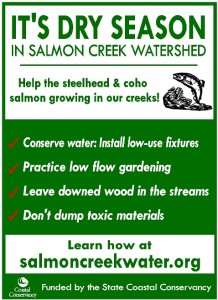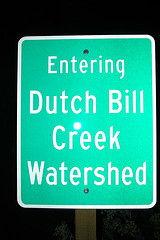2006-2007
The Southern Sonoma County Resource Consevation District’s Creek Sign Guide is available online. Download this how-to guide on getting watershed and creek signs installed in your community.
WATER Institute staff in collaboration with the West County Watershed Network, Southern Sonoma RCD and County Supervisors Mike Reilly and Mike Kearns were funded by the California Coastal Conservancy to implement the West & South Sonoma County Watershed and Creek Signage Pilot Project. Numerous signs throughout the western and southern regions of the county were installed in 2006.

The intention of our public education project is to improve community watershed literacy through a road signage program on selected county roads at their intersections with targeted creeks and watershed divides. We believe that a sense of connection to place, to ones home, is often the first step towards compelling positive action on behalf of stewarding that place. Helping communities to name their creeks and respective watershed divides can be a critical first step towards enhancing such place based watershed relationships.
At a larger level our collaborative goals share a common desire to restore and improve the ecological health of Sonoma County watersheds and to advance the recovery of endangered salmonids by increasing ecological literacy and restoration participation in our communities. The listings of various endangered salmonids in every Sonoma County watershed provide a chilling indictment of historical and current land-use practices and their harmful effects on this environmental indicator species. We believe that through community-based education and action, we can initiate behavioral changes that affect land-use practices that move us towards more restorative human settlement patterns.
All land use within any watershed that drains to the ocean impacts the health of the riparian , estuarine & coastal environments, carrying pollution and sedimentation downstream. Rapid, continuous development causes numerous negative effects to the water cycle and the habitat of terrestrial and aquatic organisms. In our home of Sonoma County, every major watershed in the county has been designated as an “impaired” waterbody. The 303d list by the State Water Resources Control Board lists the various impairments as sedimentation, temperature, and / or nutrients from runoff. Most of the county’s watersheds are facing extensive challenges including: inadequate water supplies; impending Eel River diversion reductions; excessive wastewater discharges and groundwater depletion; in addition to expansive urban development and agricultural growth projections.

All of these watersheds are home to Steelhead trout, and Chinook & Coho salmon, each species is variously listed as threatened and/or endangered, under both the California and Federal Endangered Species Acts. Ninety-five percent of Sonoma County is owned as private land, primarily used for agricultural endeavors, urban development, and rural residences. If private landowners are not aware of the need for responsible land management and do not feel compelled to participate and provide access to their land for restoration, these endangered fish species will never have any hope of recovery from the brink of extinction. Our humble signage project is a small, but critical element that will support and augment numerous other watershed efforts underway within the county.
In addition to the watershed and creek signs, the WATER Institute worked with partners of the Salmon Creek Water Conservation Program to design and install signage alerting residents and visitors to low-flow conditions as a means to encourage water conservation during these periods. These signs educate local residents and seasonal visitors about water conservation efforts in the watershed.






